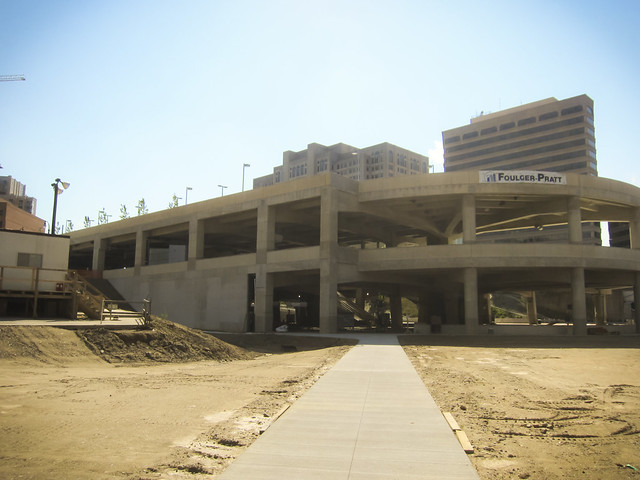To the news media
To Montgomery County MD council and executive
To the Federal Transit Administration
To the Maryland Transit Administration
To Metro users
To Metro users
To ALL US citizens
NEWS ALERT!
The Silver Spring Transit Center isn't just a Montgomery County, MD thing.
Funding for the $141+ million, severely flawed, LEMON Silver Spring Transit Center is 53% federal, 11% state and 36% Montgomery County.
Despite the fact that the news media, Montgomery County's executive and council, WMATA, the Federal Transit Administration and the Maryland Transit Administration act as if Montgomery County's Council isn't spending other peoples' money, in fact, they are.
- 53% of the funding for the SSTC comes from the general public, including all those from nearby District of Columbia and Virginia and all 50 states (most of which are distant from Montgomery County MD)
- 11% of the funding for the SSTC comes from MD citizens, including those who rarely, if ever, use Metro
- 36% of the funding for the SSTC comes from Montgomery County citizens
The bad news is that none of us were given the opportunity to ask our questions and make our comments on the public record BEFORE the decision to make "repairs" to the severely flawed, LEMON Silver Spring Transit Center was made. The good news is that FINALLY we can ALL be heard on the public record.
On Tuesday January 13, 2015 at 1:30 PM a public hearing will be held at the Montgomery County Council Hearing Room, 100 Maryland Avenue, in Rockville. The purpose of the public hearing is to present for approval a "supplemental appropriation and CIP amendment for $16,750,000" for "repairs" to the severely flawed, LEMON Silver Spring Transit Center. Those who wish to testify must call 240-777-7803 by 1/12/15 at 5 pm.
Let's have a BIG turnout from those inside and outside Montgomery County whose taxes and user fees have been spent for poor engineering design (Parsons Brinkerhoff), poor construction (Foulger Pratt, subcontractors), poor inspection and testing (Balter Co.), poor management (Montgomery County, Maryland Transit Administration, Federal Transit Administration), needed structural evaluations--because of the poor design, construction, inspection, testing and management--(KCE Structural Engineers, subconsultants, surveys, sampling, testing, etc.) and ill-advised * "repairs" to the severely flawed, LEMON Silver Spring Transit Center.
For those who are unable to attend, send your letters to George Leventhal, Chairman, Montgomery County Council, and ask that your letter be made part of the public record for the hearing.
It's way past time to stop the madness, and the bleeding, to pull the plug, and to cut the public's losses with the overdue, over-budget, severely flawed, LEMON Silver Spring Transit Center.
* ill-advised "repairs" because WMATA requires expansion joints to be located every 100 ft. (or closer) apart; the 315 ft. by 580 ft. SSTC has none. The SSTC will continue to have no expansion joints after "repairs" are made.
For those who are unable to attend, send your letters to George Leventhal, Chairman, Montgomery County Council, and ask that your letter be made part of the public record for the hearing.
It's way past time to stop the madness, and the bleeding, to pull the plug, and to cut the public's losses with the overdue, over-budget, severely flawed, LEMON Silver Spring Transit Center.
* ill-advised "repairs" because WMATA requires expansion joints to be located every 100 ft. (or closer) apart; the 315 ft. by 580 ft. SSTC has none. The SSTC will continue to have no expansion joints after "repairs" are made.
No matter what you may hear from news media, Montgomery County's executive, council, staff, consultants (paid or otherwise), supporters, the Maryland Transit Administration or the Federal Transit Admnistration, these two facts are true: (1) understrength and overstressed concrete will remain after current "repairs" have been made and (2) current "repairs" fail to deal with the likely source of the cracking--the SSTC's complete lack of expansion joints. (1) KCE found understrength and overstressed concrete all over the SSTC (see "Excerpts from KCE's SSTC structural report" below). Understrength and overstressed concrete is not being replaced with the current "repairs". (2) Current "repairs" do not add expansion joints where there are none. (3) By definition the severely flawed SSTC is a LEMON. The SSTC will remain a LEMON even after current "repairs" have been made.
Excerpts from KCE's SSTC structural report
"Based on in situ sampling and testing performed, the concrete in the structural decks has lower compressive strength than required by the Contract Documents. The compressive strength is also lower than that reported by construction period sampling and testing."
page 5, Silver Spring Transit Center Investigation Report, Volume 1, March 15, 2013, KCE Structural Engineers, PC
"... the as-designed analysis indicates the initial and service level stresses were exceeded."
page 6
"Our analysis determined that certain beams in the drive lanes do not have adequate strength to support the design loads for both as-designed and as-built conditions when the in-situ concrete strength is less than the specified concrete strength, i.e., 8,000 psi vs. 6,970 psi (the in-place strength as described herein). In addition, we again determined that initial stress limits required by Code limitations of induced stresses to control cracking at initial and service conditions were exceeded."
page 7
"Our analysis determined that the girders at limited locations do not have adequate strength to support the design loads in combined shear and torsion with either 8,000 psi or 6,970 psi concrete. In addition, stress limits at initial and service conditions exceeded design limits."
page 7
NOTES:
1. "in-situ" = in-place = as-built. After construction, when KCE was hired to perform a structural investigation of the SSTC, in-place samples of the as-built concrete were taken and tested.
2. "Strength" (e.g., "compressive strength...") is a material's inherent ability to take external loads (forces), e.g., a fully loaded bus. Lumber, steel, reinforced concrete (steel tendons and/or rebars added), etc. all have "strength", i.e. they can all take external loads (forces) to some limit without breaking. (Obviously, steel and reinforced concrete, correctly manufactured, mixed, constructed, etc. to preset industry standards, have more "strength"--ability to take larger external loads for the same span and material dimensions--than lumber.)
3. "Stress" is the internal pressure (psi or pounds per square inch) that results in lumber, steel, concrete, etc. when external loads (forces) are applied. "Failure stress" is the internal pressure limit in a material that causes it to break. (Obviously, steel and reinforced concrete have higher "failure stress limits" in pounds per square inch, or psi, than lumber.)
4. "Design stress" (e.g. "...initial and service level stresses...") is the maximum internal stress used for design. Because of variability in specimens of the same material (lumber, steel, concrete, etc.), the applied load (force) at failure for specimens of like material and size is not the same. "Design stress", therefore, is always lower than "failure stress".
 |
| Photos are taken from KCE & WMATA reports (2013) |
Transit center, White Oak plan remain key issues in Silver Spring -- Gazette.Net
"'The contractors and consultants responsible will be held fully accountable for all costs related to and resulting from the necessary remediation and subsequent costs,' Leggett said."
Really?!? When did you become a soothsayer, Leggett?
 |
| Isiah Leggett, the new Nostradamus |
GET REAL, Leggett!!!
You can't predict the future any more than I, or anybody else, can. You, of all people, should know that the judicial system (courts) will decide who pays for what, and that you alone aren't the judicial system.
Hold onto your wallets, folks!
Private lawyers, court costs, extraordinarily high operations & maintenance costs, contractors, consultants, etc. ... not to mention time and expenses connected with legal proceedings, operations, maintenance, and other SSTC issues by Montgomery County's executive, council & staff.
"In 2014, the Silver Spring Transit Center was a gift that kept giving..."
Correct!!!
and 2015, 2016, 2017, 2018, 2019, 2020...
 |
| Silver Spring Transit Center |
News media, why don't you report on how and why Montgomery County selected Parsons Brinkerhoff, Foulger Pratt and Balter Co. in the first place? It's an important part of the SSTC story.
Could it be because of your own "cozy" relationship with Montgomery County government that you haven't reported how and why Montgomery County selected Parsons Brinkerhoff, Foulger Pratt and Balter Co. in the first place?
 |
| Silver Spring Transit Center aka Paul S. Sarbanes Transit Center |
1. Attend the Jan. 13 public hearing.
2. Say NO to the proposal to raid the general fund & other projects of $21+ million for "repairs" to the LEMON SSTC.




























